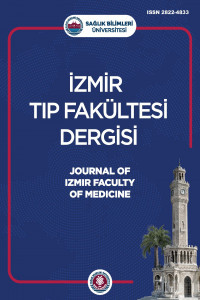Acil Servise Başvuran Çocukların Ebeveynlerinin Büyüme Ağrısı Farkındalığının Değerlendirilmesi
Büyüme ağrısı, Çocuk acil, Pediatri
The Evaluation of Growing Pain Knowledge of Parents Who Applied to the Pediatric Emergency Department
Growing pains, Pediatric emergency, Pediatric,
___
- 1) Duchamp M. Maladies De La Croissance. Paris, France: Chez l’Auteur; 1823. Available from: https://books.google.com.tr/books?hl=tr&lr=&id=1DhbAAAAcAAJ&oi=fnd&pg=PA105&ots=rQHO-4ei7S&sig=z_maYX_u7b3wBO5rDtWCUVKXfF8&redir_esc=y#v=onepage&q&f=false
- 2) Al Khattat A, Campbell J. Recurrent limb pain in childhood (“Growing pains”). Foot 2000; 10: 117-23.
- 3) Evans AM, Scutter SD, Lang LM, Dansie BR. “Growing pains” in young children: a study of the profile, experiences and quality of life issues of four to six year old children with recurrent leg pain. Foot. 2006;16:120-4.
- 4) Vehapoglu A, Turel O, Turkmen S et al. Are growing pains related to vitamin D deficiency? Efficacy of vitamin D therapy for resolution of symptoms. Med Princ Pract 2015;24:332-8.
- 5) Naish JM, Apley J. ‘Growing pains’: a clinical study of non-arthritic limb pains in children. Arch Dis Child. 1951;26:134.
- 6) Apley J. Clinical Canutes. A philosophy of paediatrics. Proc R Soc Med. 1970;63:479–84.
- 7) Evans AM, Scutter SD. Prevalence of "growing pains" in young children. J Pediatr. 2004;145:255-8.
- 8) Kelly K., Schanberg A, Schanberg LE. Growing Pains. Nelson Textbook of Pediatrics, Chapter 193, p. 1329-30. Available from: https://www.clinicalkey.com/#!/content/book/3-s2.0-B9780323529501001930?indexOverride=GLOBAL.
- 9) Petersen H. Growing pains. Pediatr Clin North Am. 1986;33:1365-72.
- 10) Abu-Arafeh I, Russell G. Recurrent limb pain in schoolchildren. Arch DisChild. 1996;74:336-9.
- 11) Evans AM. Relationship between “growing pains” and foot posture in children: single-case experimental designs in clinical practice. J Am Podiatr Med Assoc.mm2003;93:111-7.
- 12) Uziel Y, Hashkes PJ. Growing pains in children. Pediatr Rheumatol Online J. 2007;5:5.
- 13) Lee HJ, Lim KB, Yoo J, Yoon SW, Jeong TH. Effect of foot orthoses on children with lower extremity growing pains. Ann Rehabil Med. 2015;39:285-93.
- 14) Cassel EJ. The nature of suffering and the goals of medicine. N Engl J Med. 1982;306:639-45.
- 15) Williams MF. Rheumatic conditions in school children. Lancet 1928;211:720-1.
- 16) Kaspiris A, Zafiropoulou C. Growing pains in children: epidemiological analysis in a Mediterranean population. Joint Bone Spine. 2009;76:486-90.
- 17) Seham M, Hilbert EH. Muscular rheumatism in childhood. Am J Dis Child. 1933;46:826-53.
- 18) American Academy of Pediatrics. Committee on Psychosocial Aspects of Child and Family Health, Task Force on Pain in Infants, Children, and Adolescents. The assessment and management of acute pain in infants, children, and adolescents. Pediatrics 2001;108: 793–7.
- 19) Goodyear-Smith F, Arrol B. Growing pains. parents and children need reassuring about this self-limiting condition of unknown cause. BMJ. 2006;333:456-7.
- 20) Weiser P. Approach to the patient with noninflammatory musculoskeletal pain. Pediatr Clin North Am. 2012;59:471-92.
- 21. Baxter MP, Dulberg C. Growing Pains in childhood - A proposal for treatment. J Pediatr Orthop. 1988;8:402-6.
- Başlangıç: 2022
- Yayıncı: Sağlık Bilimleri Üniversitesi
Kadir Burak BİRLİK, Umut GÖK BALCI
Sosyal Medya Kullanım Bozukluğu Ölçeğinin Yetişkinlere Uyarlanması: Geçerlik ve Güvenirlik Çalışması
Zeynep Özün ERİNÇ, Gülberat İNCE, Kayı ELİAÇIK, Yasemin KILIÇ ÖZTÜRK, Ferhan ELMALI, Büşra EMİR, Muhammet Ali KANIK, Mehmet HELVACI
Metakron Multipl Primer Akciğer Kanserinde Cerrahi Tedavi: Olgu Sunumu
Dilekhan KİZİR, Celal Buğra SEZEN, Volkan ERDOĞU, Muzaffer METİN
Semra DEMİRLİ ATICI, Ufuk UYLAŞ, Cem TUĞMEN, Erdinç KAMER
Acil Servise Başvuran Çocukların Ebeveynlerinin Büyüme Ağrısı Farkındalığının Değerlendirilmesi
Mustafa İNCESU, Tuğçe NALBANT, Emel BERKSOY
Hacı Mehmet GÜNEŞ, Gaye AYDIN, Nimet ŞENOĞLU
İdiyopatik Ani Sensörinöral İşitme Kaybında Koroid Kalınlığı ve Oküler Hemodinami
Ozlem YAGİZ AGHAYAROV, Ayşe Sevgi KARADAĞ, İlker Burak ARSLAN, Sinan ULUYOL, Ejder CİĞER, İbrahim ÇUKUROVA
İnaktif Behçet Hastalığı'nda İnflamatuar Belirteçler
Ozlem YAGİZ AGHAYAROV, Aydın KESKİNRÜZGAR, Ayşe Sevgi KARADAĞ, Aynur ALİYEVA, Demet IŞIK BAYRAKTAR, İbrahim ÇUKUROVA
